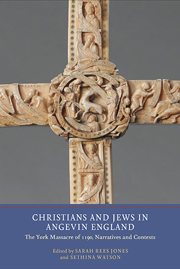Book contents
- Frontmatter
- Contents
- List of Illustrations
- Contributors
- Editor's Preface and Acknowledgments
- Abbreviations
- Introduction: The Moment and Memory of the York Massacre of 1190
- Part I The Events of March 1190
- Part II Jews among Christians in Medieval England
- Part III Representations
- 12 Egyptian Days: From Passion to Exodus in the Representation of Twelfth-Century Jewish-Christian Relations
- 13 ‘De Judaea, muta et surda’: Jewish Conversion in Gerald of Wales's Life of Saint Remigius
- 14 Dehumanizing the Jew at the Funeral of the Virgin Mary in the Thirteenth Century (c. 1170–c. 1350)
- 15 Massacre and Memory: Ethics and Method in Recent Scholarship on Jewish Martyrdom
- 16 The Future of the Jews of York
- Afterword: Violence, Memory and the Traumatic Middle Ages
- Bibliography
- Index
- York Medieval Press: Publications
13 - ‘De Judaea, muta et surda’: Jewish Conversion in Gerald of Wales's Life of Saint Remigius
from Part III - Representations
Published online by Cambridge University Press: 05 May 2013
- Frontmatter
- Contents
- List of Illustrations
- Contributors
- Editor's Preface and Acknowledgments
- Abbreviations
- Introduction: The Moment and Memory of the York Massacre of 1190
- Part I The Events of March 1190
- Part II Jews among Christians in Medieval England
- Part III Representations
- 12 Egyptian Days: From Passion to Exodus in the Representation of Twelfth-Century Jewish-Christian Relations
- 13 ‘De Judaea, muta et surda’: Jewish Conversion in Gerald of Wales's Life of Saint Remigius
- 14 Dehumanizing the Jew at the Funeral of the Virgin Mary in the Thirteenth Century (c. 1170–c. 1350)
- 15 Massacre and Memory: Ethics and Method in Recent Scholarship on Jewish Martyrdom
- 16 The Future of the Jews of York
- Afterword: Violence, Memory and the Traumatic Middle Ages
- Bibliography
- Index
- York Medieval Press: Publications
Summary
Jews are confined to the periphery in twelfth- and thirteenth-century literature. When they do appear within Christian texts, their actions and behaviour are restricted and circumscribed. Viewed as living symbols of Christ's suffering on the cross, and as actors within the wider Christian drama, their performance was interpreted through the Church's teachings. Within a literary context, as Stephen Kruger has argued, ‘Jews and Judaism can be quite easily rendered “virtual,” reduced to a nonpresence, even a non-being that functions to reconfirm a real, present Christianity’. In this way, representations of Jews were used to define the nature of Christianity, and to police the boundaries that separated each faith.
Gender roles and ideals played an important function in this respect. Jewish men were aligned with a variety of negative stereotypes, and they were frequently attributed the role of perpetrator in stories of host desecration or ritual murder. Jewish women, in contrast, were more ambiguously placed in Christian discourse. They could appear as beautiful or exotic seductresses, but also featured in a more passive respect, considered susceptible to Christian conversion, even assimilation. As such, Jewish women often walked a tightrope; depending on the narrative context they could be seen as either more or less threatening to the faithful than their male counterparts. To take one example, the Jewish woman in the twelfth-century Life of Christina of Markyate, who was ‘intent on harming Christina with particularly powerful magic’, is used by the author to demonstrate that even a wicked Jewish ‘witch’ saw that her efforts would fail, protected as Christina was by angels.
- Type
- Chapter
- Information
- Christians and Jews in Angevin EnglandThe York Massacre of 1190, Narratives and Contexts, pp. 238 - 249Publisher: Boydell & BrewerPrint publication year: 2013



